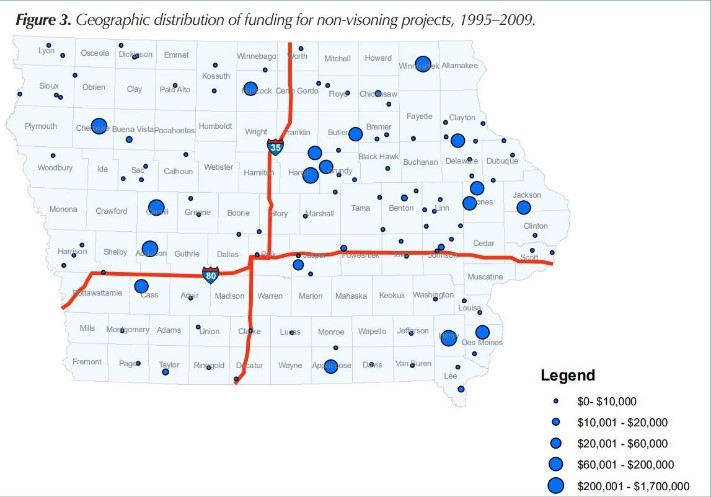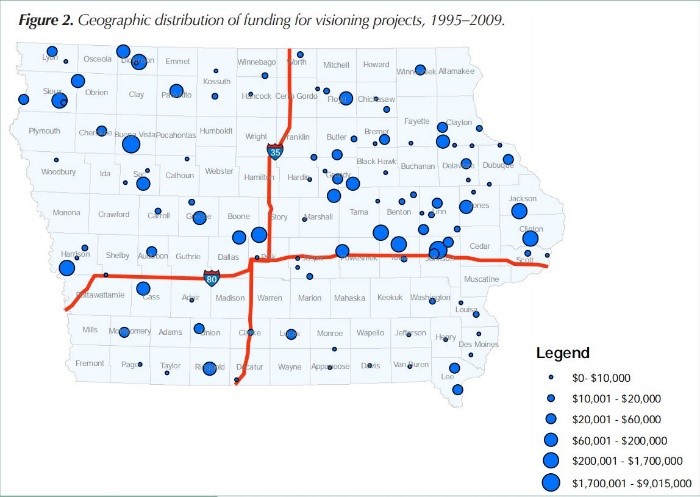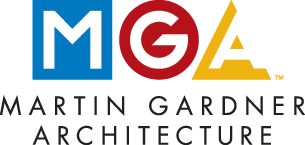Revitalizing communities and neighborhoods often start with small efforts that lead to greater and broader initiatives. This approach is important because it is practical and effective by proposing a small initial project that is easy to execute to demonstrate a success to neighbors and community members. This small success also serves as a visible seed that can help to generate support, interest, and attract more stakeholders to the table in order to scale up placemaking/revitalization projects and tackle decline as a true planning initiative community wide.
Over the past several years MGA has been involved in the Community Visioning Program, which is run in partnership with Iowa-DOT, Iowa State University Department of Landscape Architecture, and a local non-profit Trees Forever. (See http://www.communityvisioning.org/). The program focuses on Iowa communities with populations under 10,000 which often have limited resources and minimal engagement with professional architects, designers, planners, and landscape architects. The goal of the program is to bring professional services and resources to these communities to make meaningful improvements to the local landscape that include trails, crosswalks, downtown streetscapes, signage, wayfinding, native vegetation, and other projects tied to transportation. This work can then be used by the community to apply for grants, promote projects, and fundraise locally. The proposed projects for towns that participate usually start with small scale placemaking initiatives, and then tie these to broader goals, plans, and projects focused on revitalization.
A recent publication by the Center for Community Progress analyzed trends in creative placemaking on problem properties like vacant lots, vacant commercial structures, vacant or dilapidated residential structures, and underutilized or blighted neighborhood parks. The report provides insights into opportunities and obstacles that can prove helpful for implementing designs and projects proposed to communities through the Community Visioning Program. The report analyzes the types of projects being undertaken, the approximate average costs of such projects, organizations that lead such initiatives, and challenges encountered when implementing projects. Funding is unsurprisingly the largest obstacles that communities face in executing these types of projects, but it is telling that the least challenging obstacle these projects faced were resistance from the community and neighbors. This might run counterintuitive for many in the design profession who often face citizen opposition to projects that propose change. This is where we get the colorful acronyms of: NIMBY – “Not In My Back Yard,” and CAVE-people – “Citizens Against Virtually Everything.” It is also insightful that the report found that of those citizens who participate in these smaller placemaking projects, 62-percent do so to support larger neighborhood revitalization efforts. The report also contains a useful appendix that includes case studies and precedent projects that range from community pop-up potlucks, to murals, to splash pads, and new parks. The report can be downloaded here.
Link: http://action.communityprogress.net/p/salsa/web/common/public/signup?signup_page_KEY=11631
The Community Visioning website also has useful reports under their “Resources” tab that include Evaluation Reports of the program effectiveness and types of projects implemented, Annual Reports on the program, local funding sources, and marketing material that can be used by communities or local organizations for outreach or to promote the program or a particular project initiative. Of particular interest to note is in their report “The Next Step: Making Community Visions a Reality,” they have mapped the number and amount of grants statewide for communities under 10,000 that have participated in the Community Visioning Program (Figure 2) versus those that have not (Figure 3). Those communities that did participate were more successful in receiving grant funding and received greater amounts than the communities that have not participated.
Link: http://www.communityvisioning.org/wp-content/uploads/2016/10/The_Next_Step.pdf


We encourage our neighboring Iowa communities that are under 10,000 to consider applying for this program. It is easy to apply and there is no large upfront obligation that would prevent communities from applying. The application process is intentionally simple and short, and the only obligations the community has is to create a local steering committee to help schedule meetings to work with ISU and designers, and to have some organization in town to commit $2,000 to the first project to be identified by community members.
For our local communities that are over 10,000 there are also a number of resources that can assist. Besides the reports already mentioned in this article, both large and small communities can utilize the Community Project Funding Guide compiled and annually updated by Trees Forever. This great resource identifies potential grants, the types of projects that are eligible, organizations that they are open to, and links to the grant application and more detailed information for each grant.
Link: http://www.treesforever.org/Community_Project_Funding_Guide
The important take away is that whether you are a large community, a small community, a local non-profit, or a local government, revitalization and placemaking projects are achievable. There are resources to support your initiatives and funding sources to build and complete those projects. As designers MGA is enthusiastic about assisting these projects in whatever way we can. In the end our success depends on the quality, health, and wellbeing of the communities in which we live, work, and play.
